Tobago Holiday 2024
At Easter 2024, Siân and I spent two weeks on holiday on the Caribbean island of Tobago (27th March to 9th April). Although not specifically a birding trip, I did spend some of the holiday exploring the area local to our hotel in South-West Tobago and a day in the central Main Ridge Rainforest Reserve. I also spent half a day on the island of Little Tobago at the North-East end of the main island, a protected seabird reserve.
I am not a photographer, so the images accompanying this blog are essentially ‘record shots’ of some of the birds I encountered using my Nikon B700 bridge camera. Some birds were very obliging; others were far trickier to get images of! I always try to leave the birds undisturbed and let them come to me.
The hotel grounds
I’ve never been to Tobago before, and the only time we have visited the Caribbean was Grand Cayman 24 years ago on our honeymoon. When I am on holiday in a new location, I try to get to know the commoner local species as quickly as possible, as this increases the chance of noticing less common birds. Therefore, I got up at dawn on our first morning and walked the reasonably extensive hotel gardens, where I saw: Tropical Mockingbird, Bananaquit, Carib Crackle, Rufus-vented Chachalaca, Ruddy Ground Dove, Palm Tanager, Blue-grey Tanager and Spectacled Thrush.
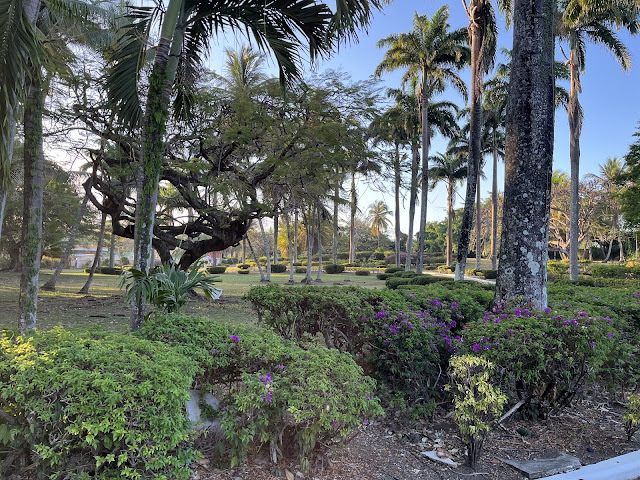 |
| Hotel gardens |
 |
| Tropical Mockingbird |
 |
| Spectacled Thrush |
 |
| Rufous-vented Chachalacas in the hotel gardens |
Before breakfast, a walk on the beach also added: Laughing Gull, Magnificent Frigatebird, Royal Tern, Ruddy Turnstone, Spotted Sandpiper and Yellow-crowned Night-Heron.
 |
| Spotted Sandpiper |
 |
| Juvenile Yellow-crowned Night Heron |
 |
| Yellow-crowned Night Heron |
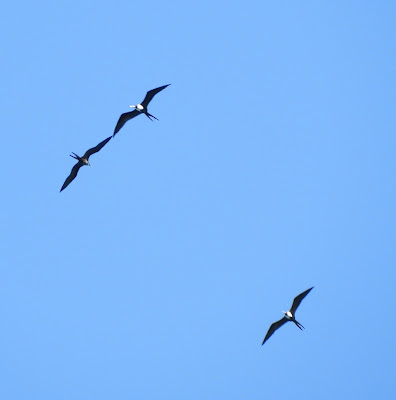 |
| Magnificent Frigatebirds constantly in the sky above the island |
The hotel buffet breakfast allowed us to see Bananaquit, Carib Crackle and Palm Tanager at very close range!
 |
| Bananaquit at breakfast |
 |
| I like my OJ served with a Palm Tanager! |
In the
hotel gardens throughout the rest of our stay I also saw: White-winged Swallow,
White-tipped dove, Yellow-bellied Elaenia, Blue-black Grassquit, Barn Swallow, Caribbean
Martin, Pale-vented Pigeon, Black-faced Grassquit, Yellow-headed Caracara, Tropical
Kingbird, Green-rumped Parrotlet, Eared Dove, Grey Kingbird and Copper-rumped
Hummingbird.
 |
| Green-rumped Parrotlet |
 |
| Copper-rumped Hummingbird (best photo I could get in the hotel gardens!) |
 |
| Tropical Kingbird |
 |
| Black-faced Grassquit |
 |
| Grey Kingbird |
 |
| Eared Dove |
 |
| 'Record shot' of Yellow-headed Caracara |
Our hotel had a private beach with a ‘swimming lagoon’ protected by a sea wall of rocks. This rock wall provided an excellent place for gulls, terns and waders to roost during the day. There was always a flock of up to eighty noisy Laughing Gulls on the wall and usually a few terns too. Up to ten Royal Terns were usually present on the wall, and Roseate Terns grew from a flock of five or six on the first days of our stay to over one hundred by the end of the holiday! Presumably, these birds were stopping off on their progress north to breed. Other birds seen on the lagoon’s rock wall were Ruddy Turnstones, Spotted Sandpiper, a Brown Pelican, an Anhinga, Sandwich Terns, a Cabot's Tern, a Lesser Black-backed Gull, two Semipalmated Plovers and a Willet.
 |
| Laughing Gulls & Roseate Terns (one tern has a ring which I can read so I will investigate!) |
 |
| Royal Tern |
 |
| A pair of Semipalmated Plovers |
 |
| Willet |
 |
| Royal, Roseate, Sandwich and Cabot's Terns |
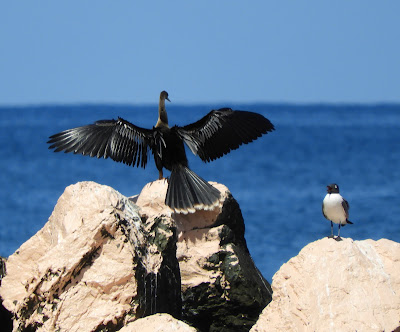 |
| Anhinga |
 |
| 90% sure that this is a 2nd year Lesser Black-backed Gull (please comment if not!) |
 |
| Brown Pelican |
The birds on the rock wall would let you swim quite close to them. What an absolute pleasure to swim in the warm Caribbean Sea and observe tens of Roseate Terns from just two meters away!
The local area
I took
several birding walks in the local area (less than 2 miles from the hotel). One
area I visited a few times was Pigeon Point, a protected and managed park incorporating
a beach, gardens and mangrove forest edge. I also visited the Bon Accord sewage ponds
(who doesn’t like a tropical sewage pond?) and the area near the ponds that was
the back of a mangrove-fringed lagoon.
At Pigeon
Point, birds I added to my trip list were: Yellow-headed Caracara, Red-crowned
Woodpecker, Mangrove Cuckoo, Grey Kingbird, Smooth-billed Ani and Peregrine
Falcon.
 |
| Pigeon Point |
 |
| Smooth-billed Ani |
 |
| Mangrove Cuckoo |
 |
| Green-rumped Parrotlets at Pigeon Point |
 |
| Peregrine Falcon |
 |
| Green Heron at Pigeon Point |
 |
| Rufous-vented Chachalaca (Tabago's national bird) at Pigeon Point |
The Bon
Accord sewage ponds, five freshwater ponds, were a great place to see water
birds; herons, Anhingas, ducks and other waterfowl. Birds seen here were: Anhinga,
Great Blue Heron, three Blue-winged Teal, Common Gallinule, Great Egret, Black-crowned
Night Heron, Wattled Jacana, Purple Gallinule, Cattle Egret, Least Grebe, Black-bellied
Whistling Duck and Great Egret.
 |
| Great Blue Heron & Anhinga |
 |
| Common Gallinule & Black-crowned Night Heron |
 |
| Common Gallinule, Wattled Jacana & Purple Gallinule |
 |
| Anhinga |
 |
| Black-bellied Whistling Duck |
Near the ponds was a road, then the path that led to the back of the mangroves. Along the road were drainage ditches that held several waders, including a Willet, two Hudsonian Whimbrel, three Lesser Yellowlegs, a Greater Yellowlegs, five Southern Lapwing and four Spotted Sandpipers. Also, several Tricoloured Heron and one Little Blue Heron. On some open ground, interspersed with trees and bushes, I saw Rufus-breasted Hermits visiting flowers (unfortunately, never stopping long enough to be photographed) and another family of Smooth-billed Ani.
 |
| Mangrove crabs |
 |
| Southern Lapwing |
 |
| Two Hudsonian Whimbrel (I wasn't expecting to see these in a swamp!) |
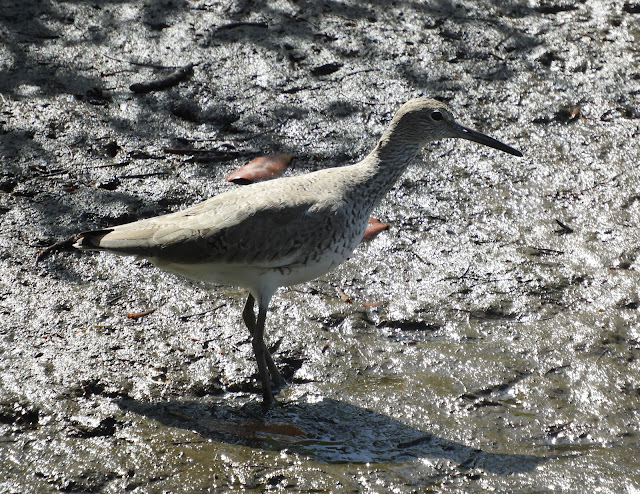 |
| Willet |
 |
| Spotted Sandpiper |
 |
| Greater and Lesser Yellowlegs |
 |
| Immature Little Blue Heron |
 |
| Tricoloured Heron |
On a walk around the airport which was close to our hotel, I found a pair of Barred Antshrike and about a dozen Brown Booby resting on some large buoys out in the sea from the end of the runway.
 |
| Male Barred Antshrike |
 |
| Brown Boobies |
Main Ridge Rainforest Reserve
On Monday,
1st April, I booked a local guide, Hans Phillips, to take Siân and me
to the rainforest. Hans drove us up the island's Atlantic (eastern) side before
heading up to the Main Ridge Rainforest reserve, the oldest protected
rainforest in the western hemisphere (apparently). Just as we passed into the
reserve, Hans pulled up, and we got out onto the road as Hans wanted to show us
a nesting colony of Crested Oropendola. There were about seven birds around,
but none posed long enough for me to get a photo of them! While waiting for the
Oropendolas, a Rufus-tailed Jacamar came, perched close to where we were parked, and gave some fantastic views.
 |
| Rufus-tailed Jacamar |
Hans then heard
a distant calling Collared Trogon, so Hans repeated the call by whistling. Over
five minutes, we had an exciting time as we could hear the Trogon getting
closer and closer with each return call. The male bird emerged from the
rainforest to appear high in a tree above us. Then another male Collared Trogon
appeared a few meters away from us at eye level, and a third male appeared in a
tree behind that bird! Hans was very excited as he’d never had three males
together before.
 |
| Collared Trogon |
 |
| Another Collared Trogon |
 |
| Collared Trogon 'B side' |
 |
| Hans, whistling up a Trogon or three! |
We then
spent a couple of hours walking into the rainforest along the Gilpin trail. The
new birds seen here were: Cocoa Woodcreeper, Red-legged Honeycreeper, White-lined
Tanager, Yellow-legged Thrush, Golden-olive Woodpecker, White-tailed Sabrewing,
Orange-winged Parrot and Stripe-breasted Spinetail. We heard several
Blue-backed Manakin calling, but they seemed to be on the other side of some
dense vegetation, so we never saw them. We also heard a Venezuelan Flycatcher
calling.
 |
| Orange-winged Parrot guarding the entrance to the Gilpin Trail |
 |
| Yellow-legged Thrush |
 |
| White-tailed Sabrewing hiding its white tail! |
Some shrill calls made our ears prick up, and Hans said it was a call from a Great Black Hawk. We looked above us and eventually saw a juvenile bird calling perched on the treetop visible from the trail path.
 |
| Juvenile Great Black Hawk |
Another highlight was watching a pair of White-tailed Sabrewing mobbing a Motmot, which is notorious for devouring hummingbird eggs and chicks.
 |
| Trinidad Motmot |
 |
| Red-legged Honeycreeper hiding in a parrot apple tree |
Being inside the rainforest was a fantastic experience, which Siân and I thoroughly enjoyed.
After emerging from the humid, damp forest back into the warm sunshine, we made our way for lunch at ‘Aunty Shurl’s Bird House Café’. Aunty Shurl was there to serve us a Dolphin fish lunch as we fed hummingbirds from our hands! White-necked Jacobins, White-tailed Sabrewing and Copper-rumped Hummingbird were feeding on the day we visited. We also saw an adult Great Black Hawk over the forest and dozens of pairs of squawking Orange-winged Parrots. Short-tailed Swift whorled about the place.
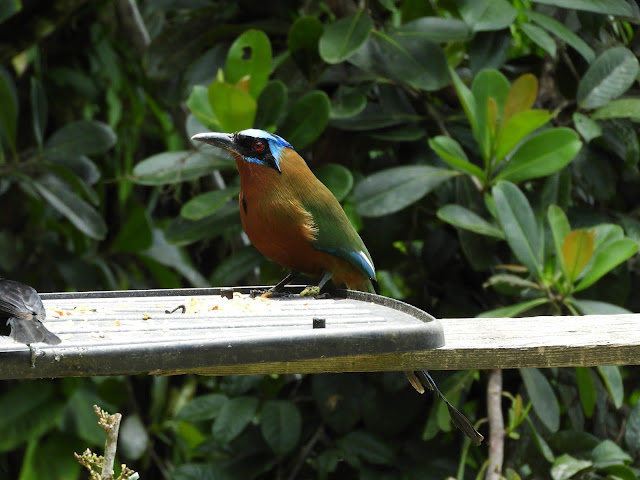 |
| Motmot on Aunty Shurl's birdtable |
 |
| Two males and a female White-lined Tanager |
 |
| Rufous-vented Chachalacas at Shurl's |
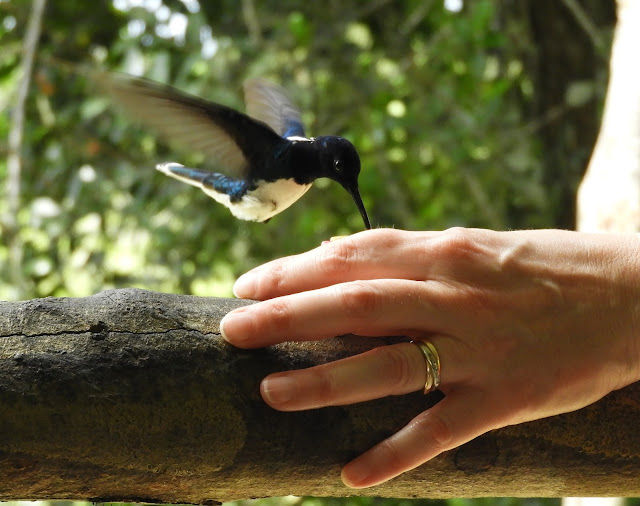 |
| White-necked Jacobin feeding from Siân's hand |
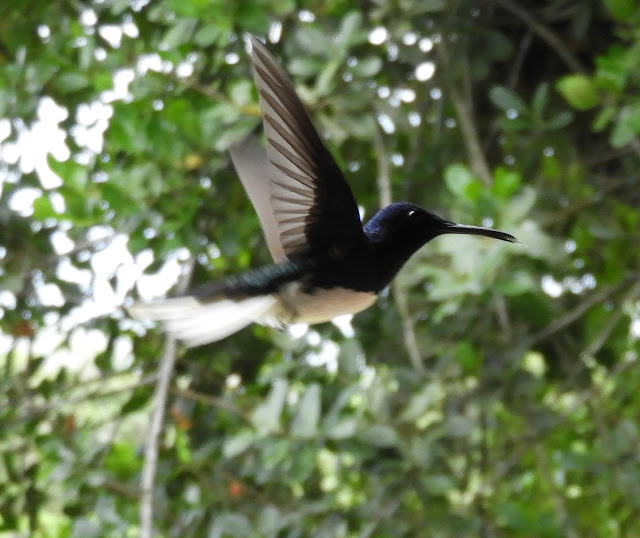 |
| White-necked Jacobin |
 |
| White-necked Jacobin |
 |
| White-tailed Sabrewing feeding from my hand |
 |
| Copper-rumped Hummingbird on Siân's hand! |
 |
| White-necked Jacobin, my hand |
 |
| Argyle Waterfalls |
Little Tobago
On Friday,
5th April, I took a taxi for 90 minutes to the Blue Waters Inn in Speyside on
the far North-East side of the island. Here, I took the boat out to Little
Tobago. On the island, a guide took us up the path to the seabird observation
area. On the way up, we came across an Audubon’s Shearwater chick, which had
wandered out of its nest borrow.
 |
| View towards Little Tobago |
 |
| Landing on Little Tobago |
 |
| Audubon’s Shearwater chick |
From the
observation point, we had fantastic views of Red-billed Tropicbirds as they
wheeled through the sky and over the forest and sea. From that point, as well as
hundreds of Magnificent Frigatebirds, we could see Red-footed Booby and Brown
Booby nesting sites.
 |
| View from Little Tobago |
 |
| Red-billed Tropicbird |
 |
| Red-billed Tropicbird |
 |
| Red-billed Tropicbird |
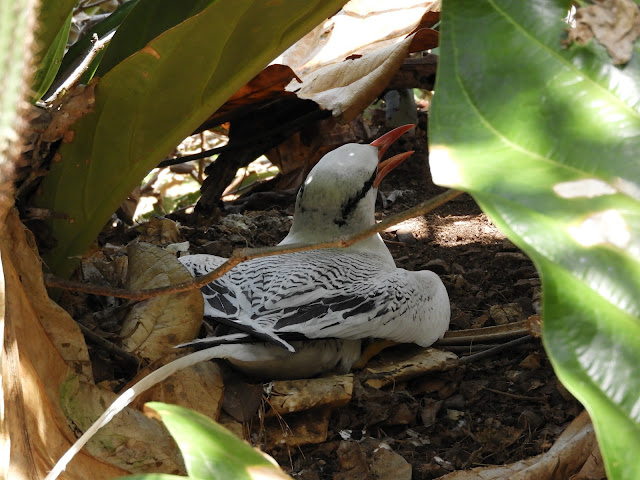 |
| Red-billed Tropicbird on the nest |
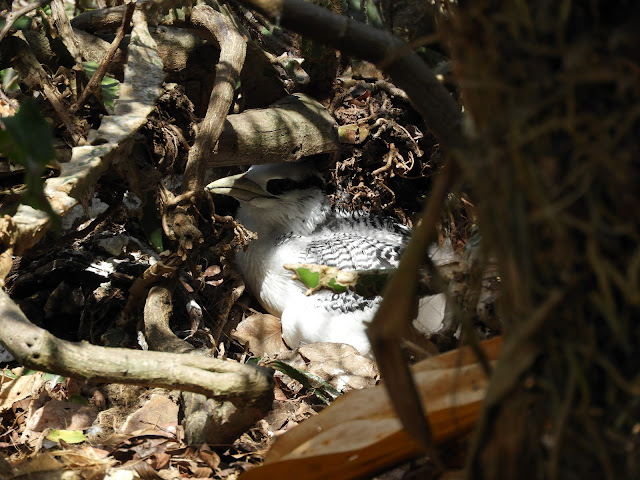 |
| Red-billed Tropicbird chick |
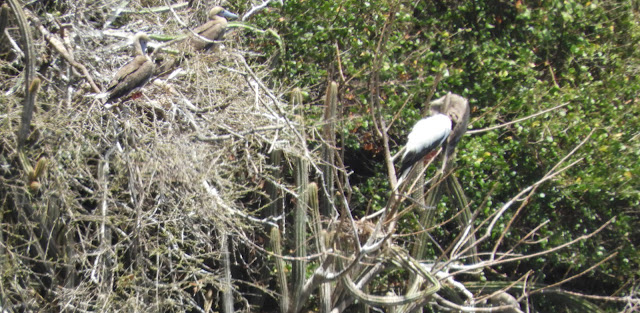 |
| Red-footed Boobies |
On the way
back down to the return boat, we saw Crested Oropendolas, a Giant Cowbird, and
I found a Chivi Vireo.
I enjoyed our
holiday in Tobago and the chance to see some new species of birds, and I had some
wonderful experiences seeing them. The total tally for the trip was 86 species
seen or heard. Here is the complete list in the approximate order that I encountered
them:
Laughing Gull
Tropical
Mockingbird
Magnificent
Frigatebird
Bananaquit
Carib
Crackle
Rufus-vented
Chachalaca
Ruddy
Turnstone
Ruddy
Ground Dove
Blue-grey
Tanager
Spectacled
Thrush
Yellow-crowned
Night-Heron
Spotted
Sandpiper
White-winged
Swallow
Royal Tern
Cabot's Tern
Brown
Pelican
White-tipped
dove
Anhinga
Sandwich
Tern
Copper-rumped
Hummingbird
Roseate
Tern
Lesser
Black-backed Gull
Yellow-bellied
Elaenia
Blue-black
Grassquit
Barn Swallow
Palm
Tanager
Caribbean
Martin
Pale-vented
Pigeon
Black-faced
Grassquit
Yellow-headed
Caracara
Tropical
Kingbird
Green-rumped
Parrotlet
Red-crowned
Woodpecker
Eared Dove
Mangrove
Cuckoo
Trinidad
Motmot
Great Blue
Heron
Blue-winged
Teal
Common Gallinule
Black-crowned
Night Heron
Wattled
Jacana
Purple
Gallinule
Cattle
Egret
Least Grebe
Black-bellied
Whistling Duck
Grey
Kingbird
Feral
Pigeon
Smooth-billed
Ani
Green Heron
Barred
Antshrike
Brown Booby
Southern
Lapwing
Cocoa
Woodcreaper
Great Black
Hawk
Red-legged
Honeycreeper
White-lined
Tanager
Yellow-legged
Thrush
House Wren
Blue-backed
Manakin (heard)
Venezuelan
Flycatcher (heard)
Golden-olive
Woodpecker
Green
Kingfisher
Rufus-tailed
Jacamar
Collared
Trogon
White-tailed
Sabrewing
White-necked
Jacobin
Short-tailed
Swift
Orange-winged
Parrot
Crested
Oropendola
Stripe-breasted
Spinetail
Rufus-breasted
Hermit
Peregrine
Falcon
Snowy Egret
Audubon’s
Shearwater (chick)
Red-billed
Tropicbird
Red-footed
Booby
Chivi Vireo
Giant
Cowbird
Semipalmated
Plover
Willet
Hudsonian Whimbrel
Lesser
Yellowlegs
Greater
Yellowlegs
Tricoloured
Heron
Great Egret
Little Blue
Heron
Mammals and
reptiles seen:
Green
Iguana
Giant
Ameiva Lizard
Common
House Gecko
Red-tailed
Squirrel
Agouti
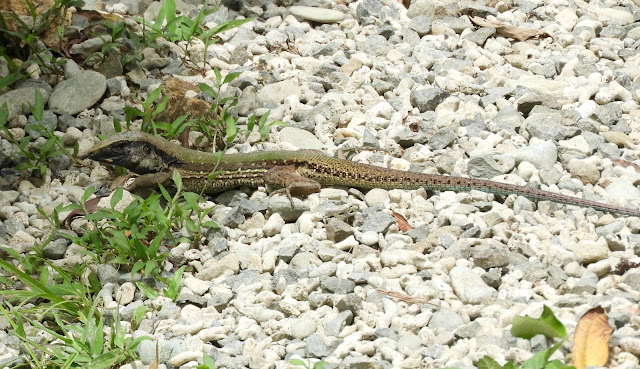 |
| Giant Ameiva Lizard |
 |
| Back end of an Agouti disappearing into the forest! |
 |
| Common House Gecko |
 |
| Red-tailed Squirrel |
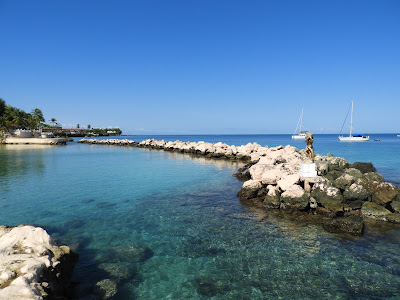




Fantastic post Paul! Some wonderful photos of some wonderful birds there. A magical place. All the best. Matt.
ReplyDeleteThanks Matt! Yes, a wonderful place, lovely people and easy birding. Thanks for your help with some of the IOC updated naming of birds.
Delete